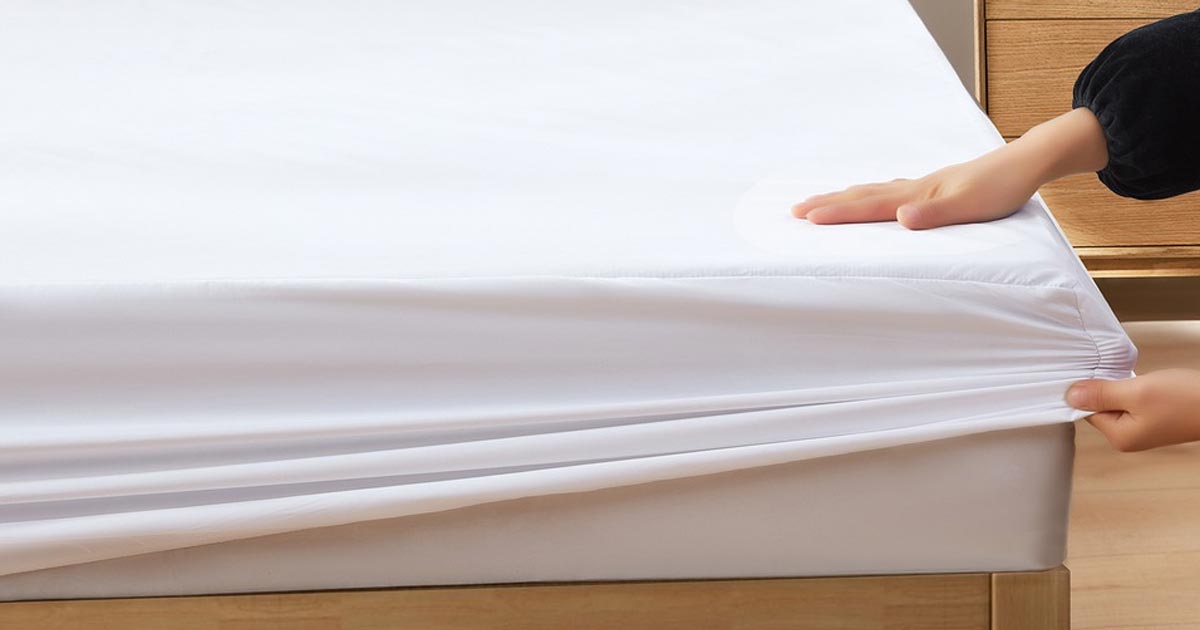How To Wash A Mattress Protector? Here Are The Tips To Get Your Washing Game Right
Know Your Mattress Protector
A mattress protector is a fitted sheet that protects your sleeping surface from regular spills and mishaps. It’s also known as a mattress cover. It’s similar to a sturdy fitted sheet that sits between your real bed sheets and the surface of your mattress (or pad).
A mattress pad and a mattress protector are two different things. Any thin covering that gives additional support, or comfort to your bed is referred to as a mattress pad. Only the mattress is protected with a mattress protector. Mattress pads are often placed on top of the mattress, beneath any topper, protector, or sheets. The “padding” substance is usually included within a quilted fabric liner.
If an unpleasant material, such as juice, falls into your bed, the mattress cover acts as a barrier. Your favorite and costly mattress will be spared since the juice will stop at your sheets.
The majority of mattress protectors cover the mattress’s top and sides. They may even cover the bottom in some cases.
Mattress protector reduces cleaning expenses and improves sleep quality by providing water resistance and anti-allergenic characteristics. Depending on the material, they can protect your sleep cycle and mattress from a variety of risks. These include, but are not limited to, the following:
- Stains and liquids
- Bedbugs
- Dust mites
- Bacteria
- Allergens
- Overheating/Sweats
Most folks think of mattress protectors as a waterproof layer to keep moisture out of their beds. Hypoallergenic kinds can help you maintain your general cleanliness and wellness while also extending the life of your bed.
Cleaning a Mattress Protector
It can be a difficult task. There are so many various sorts of protectors, and each one appears to have its own set of cleaning instructions. Following such instructions and cleaning is a fantastic method to prevent allergies and dust mites from accumulating.
Hand Cleaning
Manually washing your mattress protector is the best method to maintain it in top shape.
-
Get a mattress protector ready
Removing the mattress protector off the bed is the first step in cleaning it. Clean the sides of the mattress protector using a vacuum cleaner, making sure to get into any creases or corners. If your bed has a fitted sheet, remove that as well and vacuum below it for extra cleaning.
-
Look for any open seams
You should inspect your mattress protector for any open seams before washing it. If you start washing your mattress protector with the seams open, the feathers and other debris from the cover, depending on the material, might block your washing machine.
Your guardian will also be ruined as a result of this. So, before you wash it, examine it properly to see if there is any open seam; and try to mend them.
-
Use a moist cloth and baking soda in warm water
Use a moist cloth (or paper towel) and warm water with baking soda to clean the mattress protector once it has been removed and cleaned.
Baking soda is an excellent home treatment for difficult stains and odors that have developed over time. It’s very effective at soaking perspiration! Simply spray a thin mist of water on any place you wish to spot clean with a spray bottle. Sprinkle with baking soda and wait to absorb any stain for a few hours. To clean up any leftover, use paper towels.
Scrub the area with a little baking soda and water mixture for around ten minutes if you have some extremely tenacious stains. The chemicals will combine to form an abrasive paste that will extract dirt from between your fingernails and cloth fibers, as well as dissolve oils to break down any persistent stains.
Keep in mind that you’ll need to flip the mattress protector over to receive full coverage.
-
Allow 24 hours for air drying
Allow the mattress protector to air dry for at least 24 hours once you’re happy with its cleanliness before replacing it on your mattress.
To avoid dust being caught in the fibers, make sure you don’t leave any suction line or marking.
How to wash a mattress protector in the washing machine
-
Prepare the mattress protector and clean the spots
Remove the protector from the bed and vacuum both sides to remove any dust and grime, as described above. If you want to take it a step further, you may spot clean with baking soda first. To eliminate any odor that may have slipped in during usage, toss a scoop of baking soda into your washer. If you’re using sheet softeners or dryer balls, be sure they’re fragrance-free to prevent odors from returning. Essential oils are sometimes used. You can also use a linen mist spray on your made bed rather than putting perfume to the protector if you want a beautiful scent finish.
-
Look for any open seams
As in the case of hand washing, do this checking.
-
Stains should be pre-treated
To guarantee that all stains are removed, use a light detergent directly to the spots and let it settle for a few minutes before putting the protector in the washer.
Allow at least 15 minutes for the detergent to permeate into the spots. This will make it easier to remove stains from the protector when it is washed.
-
Fill a wash bag with the mattress protector
Place the mattress protector in the washing machine in a laundry bag. If you don’t have a laundry bag, place it inside an old pillowcase. This keeps the washing machine from snagging on other objects while it’s being washed.
-
Wash in cold water on a gentle cycle
Wash the protector in cold/warm water on a gentle cycle for 15 minutes or until clean. This will help preserve it from wear and strain as the procedure progresses. It’s crucial not to use too hot water since it might shrink or harm the top plastic material that most mattress covers are made of.
We recommend using a mild (non-builder) washing detergent and avoiding using any harsh chemicals like bleach. If you do, the natural materials’ lifespan will be shortened.
-
Twice rinsing the mattress protector is ideal
You should rinse your mattress protector twice to remove all of the detergent. This means you’ll have to leave your mattress protector in the washer and run it again when the cycle is finished, but this time without the detergent.
-
Your mattress protector should be completely dry
If you wish to tumble dry your mattress protector, do so with your other laundry and on a low heat setting. Stop the dryer every 20 minutes and break up its content if you’re tumble drying it alone without any other clothes to assist break it up. If you do not do so, the content of your mattress protector will dry in lumps, destroying the smoothness of your mattress protector.
To avoid wrinkling, remove the protector from the dryer as soon as the cycle is over.
Or, when finished, remove from washer and place on dryer rack to air dry.
To dry the mattress protector, remove it from the washing machine and place it on a dryer rack. It’s possible that your protector will take up to 24 hours to dry fully, so plan ahead!
A Few more Tips
A waterproof mattress protector should not be put in a dryer
It is not suggested to use a tumble dryer to dry a waterproof mattress protector. It may hurt it and make it less effective at its purpose. If you do so, make sure you use a low heat setting and that the protector was cleaned in cold water when you bought it.
How often to wash mattress protector?
Washing your protector every couple of months or once a month for individuals who sweat a lot is a decent rule of thumb.
If you suffer from allergies or have pets that lie in your bed, you will need to wash it more frequently. In addition, if you spill something on your mattress cover and notice a stain, you should wash it right away to prevent the stain from settling.
Dust, grime, mould spores, and other allergens are easier to keep off your skin if the surface is clean and dry. Not only that, but also allows ventilation from beneath your mattress to keep you cooler at night.
Dry cleaning your mattress protector is not recommended
A waterproof mattress protector should never be dry cleaned or ironed, since this might harm the waterproof barrier.
The Last Words
Your mattress protector should be cleaned on a regular basis as part of your laundry regimen. Taking the effort to clean and care for your protector is a fantastic method to prevent the build-up of allergies and dust mites that will surely arise if not properly cared for.









